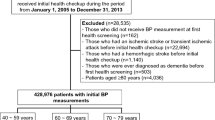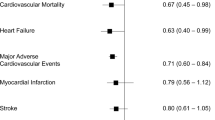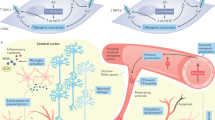Abstract
Hypertension is an established risk factor for stroke and other cerebrovascular disorders. Both stroke and small lacunar infarcts or white matter lesions can cause cognitive impairment and dementia, and there is evidence that vascular risk factors play a major role in the development of both Alzheimer's disease and vascular dementia. Several large epidemiological studies have shown that raised blood pressure in midlife is a strong risk factor for dementia later in life; however, blood pressure often decreases following the development of dementia. The cognitive function hypothesis proposes that elevated blood pressure increases the risk of decline of cognitive function, and that this can be reversed by active lowering of blood pressure. Evidence in support of this hypothesis comes from the Syst-Eur Dementia project, and from a number of smaller studies. SCOPE (Study on Cognition and Prognosis in the Elderly) is a large prospective study involving almost 5000 elderly patients (age 70–89 years), who are randomised to receive candesartan cilexetil, 8–16 mg, or placebo. Candesartan was chosen for this study because it is effective and well tolerated in elderly patients. SCOPE should provide important information on the long-term effects of AT1-receptor blocker treatment with candesartan on morbidity—including effects on cognitive function—and cardiovascular mortality in elderly hypertensive patients.
This is a preview of subscription content, access via your institution
Access options
Subscribe to this journal
Receive 12 digital issues and online access to articles
$119.00 per year
only $9.92 per issue
Buy this article
- Purchase on Springer Link
- Instant access to full article PDF
Prices may be subject to local taxes which are calculated during checkout




Similar content being viewed by others
References
Kannel WB, Gordon T . Evaluation of cardiovascular risk in the elderly: the Framingham Study Bull NY Acad Med 1978 54: 573–591
Joint National Committee. Sixth National Report of the Joint National Committee on Prevention, Detection, Evaluation and Treatment of High Blood Pressure (JNC VI) Arch Intern Med 1997 157: 2413–2446
Staessen JA et al. Risks of untreated and treated isolated systolic hypertension in the elderly: meta-analysis of outcome trials Lancet 2000 355: 865–872
American Psychiatric Association. Diagnostic and statistical manual of mental disorders, 3rd edition, revised American Psychiatric Association: Washington DC 1987
Jorm AF, Korten AE, Henderson AS . The prevalence of dementia: a quantitative integration of the literature Acta Psychiatr Scand 1987 76: 465–479
Tzourio C, Anderson C PROGRESS Management Committee. Blood pressure reduction and risk of dementia inpatients with stroke: rationale of the dementia assessment in PROGRESS (Perindopril Protection against Recurrent Stroke Study). PROGRESS Management Committee J Hypertens 2000 18 (Suppl): S21–24
Hofman A et al. Atherosclerosis, apolipoprotein E, and prevalence of dementia and Alzheimer's disease in the Rotterdam Study Lancet 1997 349: 151–154
Snowdon DA et al. Brain infarction and the clinical expression of Alzheimer disease. The Nun Study JAMA 1997 278: 113–114
Elias MF et al. Untreated blood pressure level is inversely related to cognitive functioning: the Framingham Study Am J Epidemiol 1993 138: 353–364
Launer LJ et al. The association between midlife blood pressure levels and late-life cognitive function. The Honolulu-Asia Aging Study JAMA 1995 274: 1846–1851
Skoog I et al. 15-year longitudinal study of blood pressure and dementia Lancet 1996 347: 1141–1145
Scheinberg P . Dementia due to vascular disease: a multifactorial disorder Stroke 1988 19: 1291–1299
Román GC . Senile dementia of the Binswanger type: a vascular form of dementia in the elderly JAMA 1987 258: 1782–1788
Brun A, Englund E . A white matter disorder in dementia of the Alzheimer type: a pathoanatomical study Ann Neurol 1986 19: 253–262
Trenkwalder P et al. Prevalence, awareness, treatment and control of hypertension in a population over the age of 65 years: results from the Starnberg Study on Epidemiology of Parkinsonism and Hypertension in the Elderly J Hypertens 1994 12: 709–716
Forette F et al. Prevention of dementia in randomised double-blind placebo-controlled Systolic Hypertension in Europe (Syst-Eur) trial Lancet 1998 352: 1347–1351
Tedesco MA et al. Comparison of losartan and hydrochlorothiazide on cognitive function and quality of life in hypertensivepatients Am J Hypertens 1999 12 (11 Pt 1): 1130–1134
Hansson L et al. Study on COgnition and Prognosis in the Elderly (SCOPE) Blood Press 1999 8: 177–183
Hansson L et al. Study on COgnition and Prognosis in the Elderly (SCOPE): baseline characteristics Blood Press 2000 9: 146–151
Elmfeldt D, George M, Hüber R, Olofsson B . Candesartan cilexetil, a new generation angiotensin II antagonist, provides dose dependent antihypertensive effect J Hum Hypertens 1997 11 (Suppl 2): S49–S53
McInnes GT, O'Kane KPJ, Jonker J, Roth J . The efficacy and tolerability of candesartan cilexetil in an elderly hypertensive population J Hum Hypertens 1997 11 (Suppl 2): S75–S80
Neldam S, Forsen B for the Multicentre Study Group. Antihypertensive treatment in elderlypatients aged 75 years or over: a 24-week study of the tolerability of candesartan cilexetil in relation to hydrochlorothiazide Drugs Aging 2001 18: 225–232
Malmqvist K, Kahan T, Dahl M . Angiotensin II type 1 (AT1) receptor blockade in hypertensive women:benefits of candesartan cilexetil versus enalapril or hydrochlorothiazide Am J Hypertens 2000 13: 504–511
Belcher G et al. Safety and tolerability of candesartan cilexetil in the elderly J Hypertens 1998 16 (Suppl 2): 249
Author information
Authors and Affiliations
Corresponding author
Rights and permissions
About this article
Cite this article
Trenkwalder, P. Potential for antihypertensive treatment with an AT1-receptor blocker to reduce dementia in the elderly. J Hum Hypertens 16 (Suppl 3), S71–S75 (2002). https://doi.org/10.1038/sj.jhh.1001443
Published:
Issue Date:
DOI: https://doi.org/10.1038/sj.jhh.1001443
Keywords
This article is cited by
-
An integrative genome-wide transcriptome reveals that candesartan is neuroprotective and a candidate therapeutic for Alzheimer’s disease
Alzheimer's Research & Therapy (2016)
-
Angiotensin II induces human astrocyte senescence through reactive oxygen species production
Hypertension Research (2011)
-
Pathways involved in the transition from hypertension to hypertrophy to heart failure. Treatment strategies
Heart Failure Reviews (2008)



